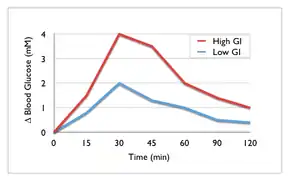Postprandial glucose test
A postprandial glucose (PPG) test is a blood glucose test that determines the amount of glucose, in the plasma after a meal.[1] The diagnosis is typically restricted to postprandial hyperglycemia due to lack of strong evidence of co-relation with a diagnosis of diabetes.[1]
| Postprandial glucose test | |
|---|---|
 Changes in blood glucose over time following a high and low glycemic index (GI) carbohydrate. | |
| Purpose | determines the amount of a type of sugar after a meal |
American Diabetes Association do not recommend a PPG test for determining diabetes;[2] it though notes that postprandial hyperglycemia does contribute to elevated glycated hemoglobin levels (a primary factor behind diabetes) and recommends testing and management of PPG levels for those patients who maintain optimum pre-prandial blood glucose levels but have high A1C values.[3]
Carbohydrate in the form of glucose is one of the main constituents of foods and assimilation starts within about 10 minutes.[1] The subsequent rate of absorption of carbohydrates in conjunction with the resultant rates of secretion of insulin and glucagon secretion affects the time-weighed PPG profile.[1]
In adiabetic individuals, levels peak at about an hour after the start of a meal, rarely exceed 140 mg/dl, and return to preprandial levels within 2–3 hours.[1] These time-profiles are heavily altered in diabetic patients.[1]
Typically, PPG levels are measured after about 2 hours from the start of the meal which corresponds to the time-span in which peak values are typically located, in case of diabetic patients.[1]
In 2011, International Diabetes Federation noted elevated PPG levels to be an independent risk factor for macrovascular disease; this had been since challenged on previous grounds and that PPG might be simply a marker or a surrogate of a complex series of metabolic events occurring in the postprandial period, that is already better reflected through other parameters.[4] A detailed 2001 review by American Diabetes Association had earlier noted that correlation of PPG values with other diabetics-parameters were often understudied and widely variant whilst chronic diabetes-related-complications have been demonstrated over a too broad range of PPG values, to be independently attributed to; the latest 2018 Standards of Medical Care in Diabetes follows the same theme roughly.[1][3] A 2019 review in Obesity Reviews was similar and noted inconclusive data, as to the importance of PPG as a standalone parameter in diabetes diagnosis and management; it went on to propose a hyperglycemia-diabetes-CVD continuum and also criticized the lack of rigid standardization of a PPG test.[5]
Reference works have recommended a peak postprandial glucose level of 140 mg/dl for any adult below 50 years of age; whilst raising it to 150 mg/dl and 160 mg/dl for patients aged between 50 and 60 years and more than sixty years, respectively.[6][7]
See also
References
- Association, American Diabetes (2001-04-01). "Postprandial Blood Glucose". Diabetes Care. 24 (4): 775–778. doi:10.2337/diacare.24.4.775. ISSN 0149-5992. PMID 11315848.
- Association, American Diabetes (2018-01-01). "2. Classification and Diagnosis of Diabetes: Standards of Medical Care in Diabetes—2018". Diabetes Care. 41 (Supplement 1): S13–S27. doi:10.2337/dc18-S002. ISSN 0149-5992. PMID 29222373.
- Association, American Diabetes (2018-01-01). "6. Glycemic Targets: Standards of Medical Care in Diabetes—2018". Diabetes Care. 41 (Supplement 1): S55–S64. doi:10.2337/dc18-S006. ISSN 0149-5992. PMID 29222377.
- Avogaro, Angelo (2011-10-01). "Postprandial Glucose: Marker or Risk Factor?". Diabetes Care. 34 (10): 2333–2335. doi:10.2337/dc11-1442. ISSN 0149-5992. PMC 3177738. PMID 21949226.
- Blaak, E E; Antoine, J-M; Benton, D; Björck, I; Bozzetto, L; Brouns, F; Diamant, M; Dye, L; Hulshof, T; Holst, J J; Lamport, D J (October 2012). "Impact of postprandial glycaemia on health and prevention of disease". Obesity Reviews. 13 (10): 923–984. doi:10.1111/j.1467-789X.2012.01011.x. ISSN 1467-7881. PMC 3494382. PMID 22780564.
- Pagana, Kathleen Deska; Pagana, Timothy J.; Pagana, Theresa N. (2016-09-03). Mosby's Diagnostic and Laboratory Test Reference. Elsevier Health Sciences. p. 453. ISBN 9780323399203.
- "Glucose: Reference Range, Interpretation, Collection and Panels". 2019-07-25.
{{cite journal}}: Cite journal requires|journal=(help)
External links
 Media related to Postprandial glucose test at Wikimedia Commons
Media related to Postprandial glucose test at Wikimedia Commons